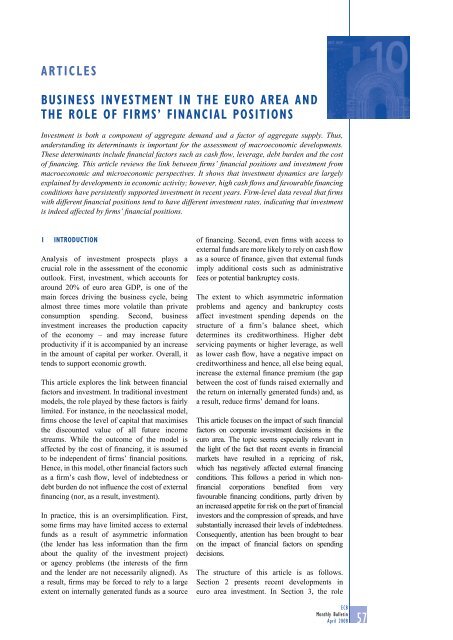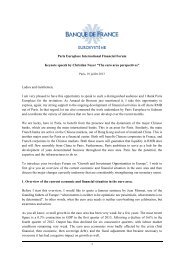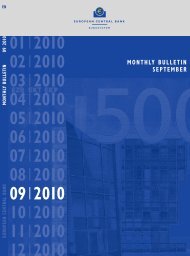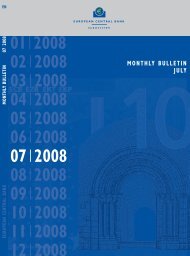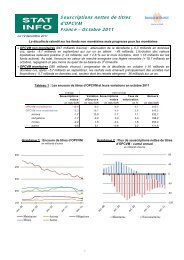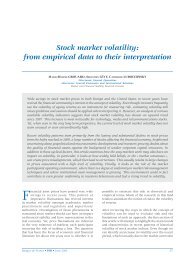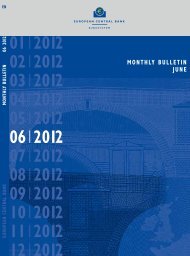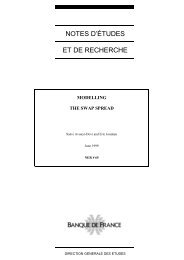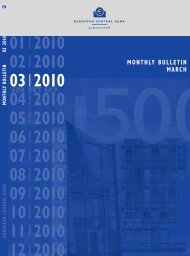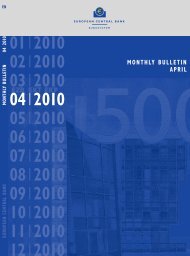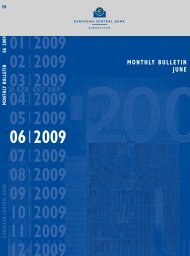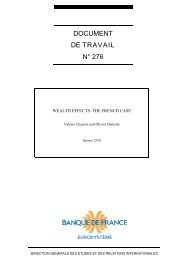Monthly Bulletin April 2008 - European Central Bank - Europa
Monthly Bulletin April 2008 - European Central Bank - Europa
Monthly Bulletin April 2008 - European Central Bank - Europa
You also want an ePaper? Increase the reach of your titles
YUMPU automatically turns print PDFs into web optimized ePapers that Google loves.
ARTICLES<br />
BUSINESS INVESTMENT IN THE EURO AREA AND<br />
THE ROLE OF FIRMS’ FINANCIAL POSITIONS<br />
Investment is both a component of aggregate demand and a factor of aggregate supply. Thus,<br />
understanding its determinants is important for the assessment of macroeconomic developments.<br />
These determinants include fi nancial factors such as cash fl ow, leverage, debt burden and the cost<br />
of fi nancing. This article reviews the link between fi rms’ fi nancial positions and investment from<br />
macroeconomic and microeconomic perspectives. It shows that investment dynamics are largely<br />
explained by developments in economic activity; however, high cash fl ows and favourable financing<br />
conditions have persistently supported investment in recent years. Firm-level data reveal that fi rms<br />
with different fi nancial positions tend to have different investment rates, indicating that investment<br />
is indeed affected by fi rms’ fi nancial positions.<br />
1 INTRODUCTION<br />
Analysis of investment prospects plays a<br />
crucial role in the assessment of the economic<br />
outlook. First, investment, which accounts for<br />
around 20% of euro area GDP, is one of the<br />
main forces driving the business cycle, being<br />
almost three times more volatile than private<br />
consumption spending. Second, business<br />
investment increases the production capacity<br />
of the economy – and may increase future<br />
productivity if it is accompanied by an increase<br />
in the amount of capital per worker. Overall, it<br />
tends to support economic growth.<br />
This article explores the link between financial<br />
factors and investment. In traditional investment<br />
models, the role played by these factors is fairly<br />
limited. For instance, in the neoclassical model,<br />
firms choose the level of capital that maximises<br />
the discounted value of all future income<br />
streams. While the outcome of the model is<br />
affected by the cost of financing, it is assumed<br />
to be independent of firms’ financial positions.<br />
Hence, in this model, other financial factors such<br />
as a firm’s cash flow, level of indebtedness or<br />
debt burden do not influence the cost of external<br />
financing (nor, as a result, investment).<br />
In practice, this is an oversimplification. First,<br />
some firms may have limited access to external<br />
funds as a result of asymmetric information<br />
(the lender has less information than the firm<br />
about the quality of the investment project)<br />
or agency problems (the interests of the firm<br />
and the lender are not necessarily aligned). As<br />
a result, firms may be forced to rely to a large<br />
extent on internally generated funds as a source<br />
of financing. Second, even firms with access to<br />
external funds are more likely to rely on cash flow<br />
as a source of finance, given that external funds<br />
imply additional costs such as administrative<br />
fees or potential bankruptcy costs.<br />
The extent to which asymmetric information<br />
problems and agency and bankruptcy costs<br />
affect investment spending depends on the<br />
structure of a firm’s balance sheet, which<br />
determines its creditworthiness. Higher debt<br />
servicing payments or higher leverage, as well<br />
as lower cash flow, have a negative impact on<br />
creditworthiness and hence, all else being equal,<br />
increase the external finance premium (the gap<br />
between the cost of funds raised externally and<br />
the return on internally generated funds) and, as<br />
a result, reduce firms’ demand for loans.<br />
This article focuses on the impact of such financial<br />
factors on corporate investment decisions in the<br />
euro area. The topic seems especially relevant in<br />
the light of the fact that recent events in financial<br />
markets have resulted in a repricing of risk,<br />
which has negatively affected external financing<br />
conditions. This follows a period in which nonfinancial<br />
corporations benefited from very<br />
favourable financing conditions, partly driven by<br />
an increased appetite for risk on the part of financial<br />
investors and the compression of spreads, and have<br />
substantially increased their levels of indebtedness.<br />
Consequently, attention has been brought to bear<br />
on the impact of financial factors on spending<br />
decisions.<br />
The structure of this article is as follows.<br />
Section 2 presents recent developments in<br />
euro area investment. In Section 3, the role<br />
ECB<br />
<strong>Monthly</strong> <strong>Bulletin</strong><br />
<strong>April</strong> <strong>2008</strong><br />
57


